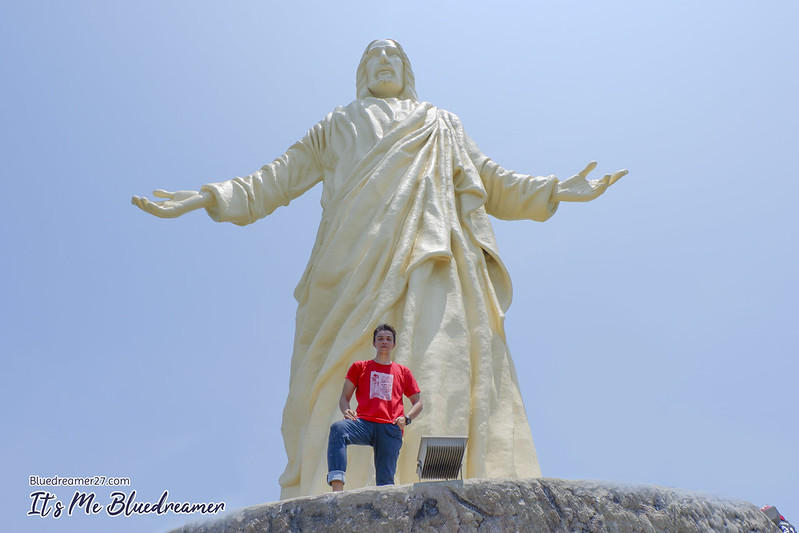A Pilgrimage to Pangasinan
Last month, I was lucky enough to join a Pilgrimage tour in Pangasinan. It was completely out of plan and I really had to make a last minute decision but I’m glad I chose to join them. Unlike the typical Visita Iglesia which we have been doing for years, we only had a chance to visit four churches in Pangasinan but we all had the opportunity to visit the Hundred Islands in Alaminos.
So now, allow me to give you a brief introduction of our recently concluded Pilgrimage in Pangasinan before we explore deeper in the history of each church. We departed from Cavite City at around 3am and was able to arrive in Alaminos at around 9 in the morning. The plan was to visit the Hundred Islands in Alaminos and most especially the newly opened “Pilgrimage Island” before we start the Visita Iglesia.
 It was my first time to visit the Hundred Islands and although it was an exhausting boat ride from one island to another, it was all worth it. We only get a chance to visit 2 islands during the 3-hour tour. We headed first in Governor’s Island where we get a panoramic view of the nearby islands before proceeding to the Pilgrimage Island.
It was my first time to visit the Hundred Islands and although it was an exhausting boat ride from one island to another, it was all worth it. We only get a chance to visit 2 islands during the 3-hour tour. We headed first in Governor’s Island where we get a panoramic view of the nearby islands before proceeding to the Pilgrimage Island.

The Pilgrimage Island in Alaminos
The Pilgrimage Island is the newest attraction in the Hundred Islands National Park in Alaminos. Formerly known as the Martha’s Island, the place dramatically transformed into an ideal pilgrim site. The island features a 56ft statue of Christ the Savior. The statue is 6ft taller than the Christ the Redeemer in Kamay ni Hesus (Check : Revisiting Kamay ni Hesus) and almost 50% taller than the Risen Christ Statue in Monasterio De Tarlac (Check : A Pilgrimage to Tarlac : Monasterio de Tarlac). Aside from the Risen Christ statue on top of the island, it also highlights various statues that depict all the 14 Way of the Cross stations. If you are going to visit all the stations, it will take you more than a thousand steps to navigate the entire island. It will be as challenging as the Via Dolorosa in Pinagmisahan Hills in Antipolo. I will post a separate entry about this island soon.

Saint Joseph The Patriarch Cathedral in Alaminos
We started our pilgrimage in Alaminos and headed to Saint Joseph The Patriarch Cathedral or simply known as the Alaminos Cathedral to recite the first three Way of the Cross Stations. Saint Joseph is the patron saint of the people of Alaminos and there were numerous miracles attributed to him. The first church was built in 1770 was utterly damaged by fire in 1817. Since then, the church underwent a series of restoration under both Augustinians and local clergies. It 1985, the church’s status was elevated to a Cathedral (still under the patronage of St Joseph).

St Peter The Martyr Parish in Sual
Our second stop is the parish in Sual, Pangasinan under the patronage of Saint Peter the Martyr. The first church was completed in 1848. The current church was the third time the building was restored much like other churches, it was also utterly damaged in numerous occasions including the Battle of Manila in 1945. The church features a simple post-Baroque style with an impressive and stunning interior.

Our Lady of Lourdes Parish in Bugallon
Our third stop is possibly one of the oldest churches in Pangasinan, the Our Lady of Lourdes Parish or more commonly known as the Salasa Parish Church.The church of Salasa under the patronage of Our Lady of Lourdes was built between 1747-1748. In 1937, the church was opened under the Capuchin monks with Our Lady of Lourdes as their Patron. However, due to the Great Flood of 1953 caused by the overflowing of Agno River, the church suffered massive damages. You can also find old ruins beside the church.

St Raymond of Peñafort Parish of Mangatarem
Our last stop is the church in Mangatarem, Pangasinan. Interestingly, it was first established as a visita (chapel of ease) of San Carlos (Pangasinan) and became an independent parish in 1835. Started as a wooden church with brick convent from 1835-1844 until it was utterly damaged by fire in 1862. The construction of the present church was completed in from 1875-1886. The church reflects an Early Renaissance architectural style. It has a simple facade with low pediment.
We could have add more churches on our list but I think the trip to Hundred Islands caught up too much time. However, it is still a spiritually rewarding pilgrimage to all of us (the parishioners of San Roque in Cavite City). Just like most of my Pilgrimage series, I am going to post a separate entry for each church on my next entries.
Also check my other Pilgrimage Series
►Pilgrimage to Tarlac
►Pilgrimage in Bataan
►Pilgrimage in Cavite
►Pilgrimage in Zambales
►Pilgrimage In Manila
►Pilgrimage in Batangas
For the mean time, feel free to follow me on my Social Media accounts for more updates
Facebook : It’s Me Bluedreamer!
Instagram : @bluedreamer1227
Twitter : @bluedreamer_27


